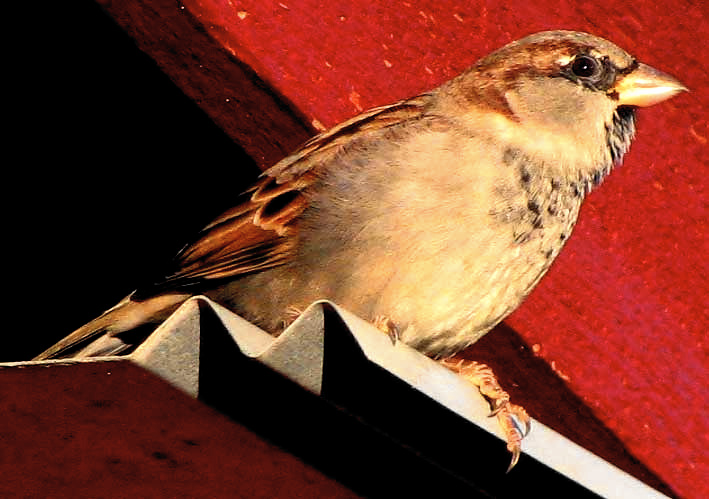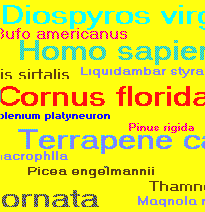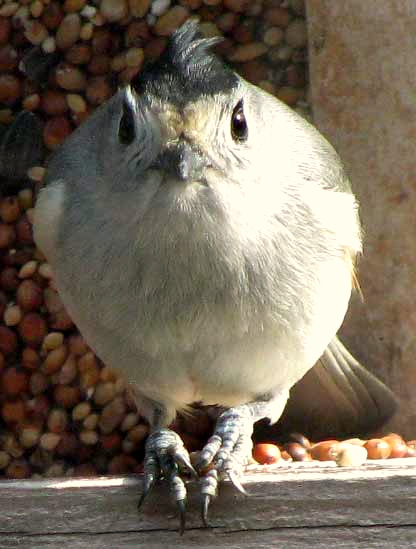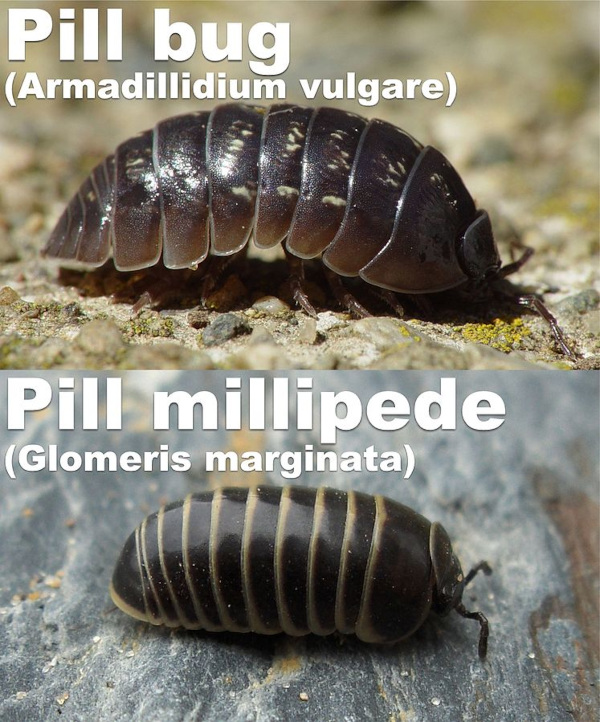
The super-abundant House Sparrow, shown at the right, occurs in many parts of the world and is known by lots of common names. In Germany it's called the
However, here's something beautiful: All serious students of Nature worldwide agree that the bird shown above is also known by the name of Passer domesticus. That's the House Sparrow's scientific name, its binomial. Sometimes binomials are called Latin names, though often binomials are based on classical Greek instead of Latin.
THE NAME'S STRUCTURE
In print, scientific names should be either italicized or underlined.

Binomials consist of two parts:
- genus name (first part)
- species name (second part)
The genus is "bigger," or more inclusive, than the species. One genus may contain many species.
For example, in North America five species of titmouse are recognized, and they are all members of the genus Baeolophus:
 Black-crested Titmouse, Baeolophus atricristatus
Black-crested Titmouse, Baeolophus atricristatus- The Tufted Titmouse is Baeolophus bicolor
- The Black-crested Titmouse is Baeolophus atricristatus
- The Bridled Titmouse is Baeolophus wollweberi
- The Oak Titmouse is Baeolophus inornatus
- The Juniper Titmouse is Baeolophus ridgwayi
You can see how similar these five species are on the Wikipedia Baeolophus Page. Those pictures demonstrate a fact about the concepts of genera and species: Species in a genus are similar to one another, but different enough to constitute a different species.
DO ALL LOOK-ALIKE THINGS BELONG TO THE SAME GENUS?
 Pill bugs, comparison of Armadillidium and Glomeris; image courtesy of 'CMBJ' via Wikimedia Commons
Pill bugs, comparison of Armadillidium and Glomeris; image courtesy of 'CMBJ' via Wikimedia CommonsThe answer lies at the right.
The pictures are even more instructive when we learn that, while both species in the picture are arthropods (phylum Arthropoda), species in the genus Armidillidium are crustaceans like shrimps and crabs (subphylum Diplopoda), while species in the genus Glomeris are millipedes (subphylum Myriapoda).
This is a classic example of convergent evolution. The process of convergent evolution is based on the fact that in specific ecological niches, such as the damp, fungusy environments both Armadillidium and Glomeris pillbugs favor, if you're a certain size, there's an optimal form your body can take to keep you alive. Over long periods of evolutionary time, gradually species arising from very different-looking ancestors will assume forms approaching that optimum form, and they'll look more and more alike.
ARE SCIENTIFIC NAMES PERMANENT?

![Huisache or Sweet Acacia, VACHELLIA [ACACIA] FARNESIANA](q/acacia-f.jpg) Acacia farnesiana
Acacia farnesianaIn the US Desert Southwest, the Sweet Acacia, or Huisache, Acacia farnesiana, shown at the right, is a common presence, often forming almost pure stands over large areas. Its fragrant, orange flowers produce considerable nectar much gathered by bees and other insects.
In 1753, the species was given its binomial name by the Swede Carl Linnaeus, the "father of modern taxonomy," and the binomial system. The name was Mimosa farnesiana. In 1806, Carl Ludwig Willdenow moved the taxon to the genus Acacia, making our desert tree Acacia farnesiana. Our tree is very widely distributed in the world's arid regions, so several botanists finding the tree in their part of the world thought they had discovered a new species, and gave it other binomials, such as Acacia acicularis, Acacia ferox and Acacia lenticellata.
![Huisache or Sweet Acacia, VACHELLIA [ACACIA] FARNESIANA](n/18/180419ac.jpg) In southwestern Texas, an ocean of orange flowering Acacia farnesiana... Or should it be called Vachellia farnesiana? Who knows?
In southwestern Texas, an ocean of orange flowering Acacia farnesiana... Or should it be called Vachellia farnesiana? Who knows?During the 1900s, two different populations of our tree were noticed in the US state of Florida, and each got a new name. However, the botanist naming them assigned them to the genus Vachellia, used for acacia-type species growing in India, plus another botanist noting our tree in Mexico proclaimed it Pithecellobium minutum.
Well, the story continues in this vein, becoming murkier and murkier. By now you get the picture.
Skipping to the present, our tree, which tentatively we're calling Acacia farnesiana, is indicated at the authoritative WorldFloraOnline.Org website as having 28 outdated names, referred to as "synonyms." Older field guides sometimes use those synonyms. Certain conservative botanists who insist that their local populations are different from all the rest continue to use them, too.
Moreover, at this writing in 2021, the species' Wikipedia Page is just one page among many on the Internet using the name Vachellia farnesiana.
 screenshot of image search page for 'sweet acacia'
screenshot of image search page for 'sweet acacia'Usually Wikipedia authors keep their taxonomy up to date. In this case, it's just hard to know which name we backyard naturalists should use. But, really, it's not a big problem for us. We can look up either name and get plenty of fascinating information about this wonderful tree.
This situation with Acacia [Vachellia] farnesiana is one of those occasional instances when it might be more straightforward to look up the common name. If with the image feature of a search engine you search on "sweet acacia" or "huisache," most of the resulting thumbnail images -- as shown above -- will show our tree, some identified as Acacia farnesiana and others as Vachellia farnesiana.
This doesn't undo the advice, however, that to get a firm hold on your Nature studies, you really need to master the binomial system.